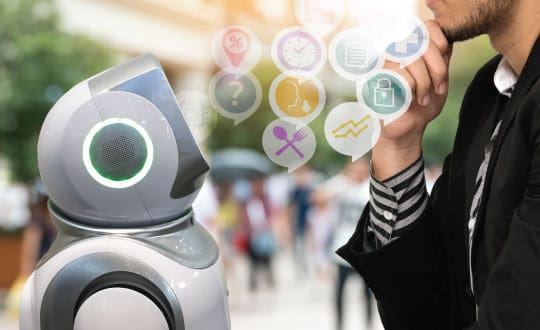Humanising technology, rehumanising technology, digital humanism. Choose the descriptor that works best for you. These terms are all being used to put people at the centre of the digital age and to explain the evolution of technology to better understand, support and augment human experiences.
Leading research firm, Gartner, has created the Digital Humanist Manifesto to help IT leaders adopt this approach.1 Josh Bersin says “technology and cognitive software will prompt us all to reinvent ourselves, become more human” 2 and the PwC 2017 CEO Survey shows that “the enduring winners will be those who can successfully navigate technology and preserve the human touch.” 3
The factors behind this movement are varied. There is a focus on enhancing user experience to engage discerning consumers (and employees). At the same time, we have access to technology that can complement and build on our capabilities and even take on human traits.
Here are five ways this trend is playing out and some of the implications for Human Resources (HR):
1. Technology Creates Better Human Experiences
Technology makes it possible to access personal, relevant content and take action when and where we need to. Done well, it simplifies our lives and makes things just work. A desire to create better workplace experiences has spurred the development of a new breed of mobile-enabled HR tools available when and where we need them. For example, PageUp’s Everyday Performance and Everyday Learning apps provide continuous feedback and learning as people engage in their work. Our ongoing investment in the PageUp marketplace gives customers access to the service providers they trust and removes friction for candidates and employees.
The widespread application of design thinking is another way this trend is playing out. Design thinking seeks to create an experience that people want and need, rather than impose a process to comply with. It’s being adopted in HR to transform outdated practices, such as performance management, and enhance employee uptake and engagement. The full potential of this approach is yet to be realisedrealized.
2. Technology has Human Characteristics
Is any of your technology smart and friendly? Perhaps it’s even funny. According to PwC, nearly 50% of people say their virtual assistant has these characteristics. Of course, the same percentage say it’s robotic and limited, and there is some way to go until these tools can hold meaningful conversations.4 Nonetheless, advances in chatbots, voice recognition and natural language processing are giving technology an increasingly human tone.
“Technology has grown manners to fit it with our ideals of social niceties” 5
We want to be treated with sympathy and care, and we appreciate a little humour. Companies such as Amazon, Google and Microsoft understand this and they are hiring behavioural scientists, comedy writers and poets in a blending of science and the arts.These conversational interfaces promise to automate many aspects of HR. If you’re embarking on this journey, start simple and focus on getting the basics right.
3. Humans Augment Smart Technology – and Vice Versa
Consider this. Technology exists for pilotless planes today, but passengers don’t have the appetite for it. Artificial intelligence makes more accurate medical diagnoses than humans, from melanoma to pneumonia, but receiving this diagnosis from a machine doesn’t sit well. Most of us would prefer to talk to a doctor, preferably one with a pleasant bedside manner, who can answer our questions and alleviate concerns. And there is nothing more frustrating than cycling through online help content and voice recognition systems that don’t understand our specific needs. Just let me talk to somebody, please!!
For the foreseeable future, a human interface will continue to be the norm in many situations and bring the intuition, empathy and creativity that we demand. Jobs will be designed for people to augment smart technology with a human touch, and this process of re-design can start in HR.
4. Technology lets us Focus on “the Human Touch”
The industrial revolution changed not only how we work but how we view work. At the turn of the last century, advances in technology meant manufacturing jobs were broken into small pieces which resulted in a deskilling of the workforce. Workers were highly productive, but no longer artisans and creators. You made a bit of an engine rather than the entire engine. At the same time there was an explosion in the number of specialisedspecialized occupations. The result – a workforce ranging from highly skilled knowledge workers through to routinisedroutinized menial work.
Fast forward 100 years to the digital revolution and exponential growth in automation, AI and machine learning. Is it different this time? Will robots or AI take our jobs? In reality less than 5% of occupations are fully automatable, but in many cases up to 30% of a role could be automated.6 This gives us the opportunity to focus our time on what we as individuals do best. Imagine a world where AI acts as your very own personal assistant. Technology has the power to remove the negative aspects from work such as bias and boredom, freeing up time and space for the uniquely human characteristics of creativity, intuition, conceptual thinking and compassion. HR can start asking critical questions now to help their company reshape for this future: What should the organisationalorganizational structure look like? How will core jobs evolve and change? How can we best equip the workforce for these future roles?
5. Technology Fosters Connections and Communities
Humans are social creatures. Being part of a community is integral to how we’re wired. We need to connect, we need to belong, we need to feel we’re part of something bigger than just ourselves. Technology has created a global village where we can just as easily converse with someone in Timbuktu as our neighbour three doors down. Instant messaging means we can “talk” to anyone, anywhere at any time. We no longer lose contact with friends and colleagues and we can join communities on just about any conceivable interest. To date, Facebook has more than two-billion active users7 and LinkedIn has half a billion professional users.8
Many organisationsorganizations are adopting internal social platforms to facilitate communication, information sharing and learning opportunities. Savvy recruiters are connecting with talent on LinkedIn, Facebook and Instagram. Most office workers (78%) view technology in the workplace as a positive force enabling them to connect with their co-workers.9 HR has an opportunity to facilitate, coordinate and drive the uptake of technology connecting talent within and outside the organisationorganization.
Where to Next?
Technology has had a profound impact on how we work and will continue to do so. HR has an opportunity to help shape the way this unfolds into the future. From allaying fears (we are not replacing you with a robot) through to reskilling employees (yes, we replaced part of your role with AI). HR has a crucial role in coaching and mentoring managers to use technology to be the best versions of themselves. We can’t hide behind the technology, we need to maintain our authenticity and vulnerability. At the end of the day we find our greatest sense of achievement doing meaningful work, with managers that recogniserecognize and support us, and being part of an organisationorganization we believe in. These are all profoundly human qualities, technology just helps create the space to do it.
Learn more about the future of HR and technology with some of our other articles, whitepapers and case studies on the PageUp Resource Hub.
Footnotes
- Definition: The Digital Humanist Manifesto created by Gartner includes three principles: (1) put people at the centre; (2) embrace unpredictability; (3) protect personal space.
- Source: Bersin, Josh (2017). The HR software market reinvents itself. HR Tech Fest, Sydney, Australia.
- Source: PwC (2017). 20 years inside the mind of the CEO … What’s next? www.ceosurvey.pwc
- Source: PwC (2017). Bot me: A revolutionary partnership. How AI is pushing man and machine closer together. www.PwC.com/CISAI
- Source: Driver, Abby (2017). Why humanizing technology is the next logical step.
- Source: McKinsey Global Institute. (2017). A future that works: Automation, employment, and productivity.
- Source: FaceBook Newsroom (2017). https://newsroom.fb.com/company-info/
- Source: Darrow, Barb (2017). LinkedIn claims half a billion users. http://fortune.com/2017/04/24/linkedin-users/
- Source: Onrec (2017). Two-thirds of UK office workers want a personal AI-powered assistant. http://www.onrec.com/news/news-archive/you%E2%80%99re-hired-two-thirds-of-uk-office-workers-want-a-personal-ai-powered-assistant
Fresh insights for HR
Stay up to date with HR trends, tips and more when you sign up for our industry newsletter






